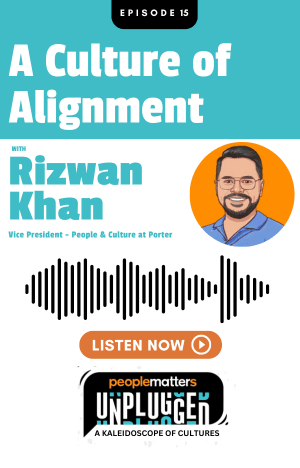Kristin Supancich of AHEAD shares 6 effective strategies for employee engagement and experience

Kristin Supancich is the Chief People Officer at AHEAD, and in a recent conversation with People Matters, she identified key elements of HR leadership for driving better employee engagement and building stronger relationships with workforce across different regions.
AHEAD now has offices in 24 locations across the United States and one in India as well, which demands redefining people and work strategies to ensure consistency in employee experience across different locations. Kristin says, “Each part of the world presents its nuances, and most employees share similar desires: a fulfilling workplace, camaraderie, a sense of purpose, and opportunities to contribute meaningfully. We strive to treat our employees like family, extending benefits and recognising the unique challenges they may face.
#1 Localising talent management - “Having a local team is imperative because, as I see it globally, while we aim for certain global alignment and practices, local customisation is essential,” shares Kristin. She explains that each employee base has unique cultural and regional needs. Investing considerable time in discussing the specific needs of our employee base and how to enhance their satisfaction and overall employee experience is a mutual learning experience for us and local teams. While a global approach is essential, customisation at the local level ensures alignment with core values while meeting unique regional needs. Therefore, collaborating closely with local HR directors allows us to achieve this balance effectively.
#2 Extending benefits with customisation options - Today, holistic well-being has gained significant importance globally. Customising benefits to suit regional needs, whether through flexible work hours or caregiving leave, or inclusive well-being programmes, which also cater to family members, including those with special needs.
Krisitin says, “We are continually evolving to better accommodate diverse needs. The pandemic has reshaped the company-employee relationship, fostering greater empathy and flexibility. Work-life boundaries have blurred, leading to a more human-centric approach to management. This shift has challenged HR leaders to adapt and support employees in new ways, ultimately enhancing organisational competitiveness and attracting top talent. For example, in the US, we placed a strong emphasis on surveying employees to identify their needs, especially during the pandemic three years ago. Our focus was on creating programmes that fostered a sense of safety and provided necessary support, such as facilitating access to vaccines and ensuring adequate medical resources.”
#3 Flexible work policies - “Initially, as we navigated the pandemic, our priority was to reassure employees that returning to the office wasn't mandatory. Instead, we concentrated on equipping them with the tools needed to perform their roles effectively from any location. As we transitioned out of the pandemic, we aimed to instil confidence in employees returning to the office.” She adds, engaging in ongoing discussions about the balance between office and remote work, contributes to enhancing employee well-being. For example, Adopting a flexible approach to accommodate varying levels of comfort and individual circumstances. Recognising that some employees may be apprehensive about returning to the office or face significant commuting challenges, we've explored alternatives like offering options for periodic office visits.
#4 Community and collaboration - While fostering an office culture is important, there are diverse ways to achieve this, especially considering the rise of hybrid and remote work models. The focus should be on aligning core values with employee feedback. Kristin adds, “Another aspect we are actively exploring is the creation of communities to foster connections among employees, regardless of their physical location. These communities serve as spaces for shared experiences, contributing to a sense of belonging and indirectly reinforcing their connection to the company. Additionally, we've initiated community service programmes, such as fundraising initiatives, which resonate universally and contribute to employee engagement and satisfaction. We understand that fostering a sense of purpose and community enhances productivity, engagement, and overall well-being. Ultimately, our goal is to create an environment where employees feel valued, connected, and empowered to contribute their best, irrespective of their location or work arrangement.”
#5 Leadership participation - “Culture only thrives when leadership actively supports, encourages, and participates in it. Leadership must lead by example. You can talk about it or write it in a book, but unless you embody it, it won't resonate,” asserts Kristin
Sharing an example, she emphasised that engaging with team members even for a coffee break conversation is an effective leadership approach. Taking a momentary break with them can lead to enhanced productivity, creativity, and overall well-being among team members. Additionally, local leaders can share examples of best practices and strategies in company-level meetings to educate team members, thereby enhancing efficiency and productivity.
You may also like:
- Are your productivity metrics outdated?
- This firm just expanded its office in Singapore – Here are exclusive tips for hiring in new geography
#6 Learning and development - Focusing on educating employees about various global perspectives and initiatives, and highlighting individuals' stories or videos showcasing excellent work happening in different parts of the world, is an effective way to encourage learning and development for global teams. Kristin suggests initiatives like cultural training sessions for understanding and managing a workforce spread across multiple countries. This training not only educates about cultural sensitivity but also about recognising differences in processes and operations across various regions. For instance, a certification may hold different significance in different countries, so it's crucial to understand and respect these differences.
“This initiative also gathers feedback and refines our approach, which is essential to strike a balance between global alignment and local adaptation, a task that can be both complex and exciting. Our local HR leaders and operations managers play a crucial role in educating and sharing best practices across the organisation, such as stress management strategies. By sharing such experiences and strategies, we aim to support each other's well-being and productivity. Additionally, we encourage employees to take ownership of their learning journey while providing them with the resources and support they need to succeed.”














